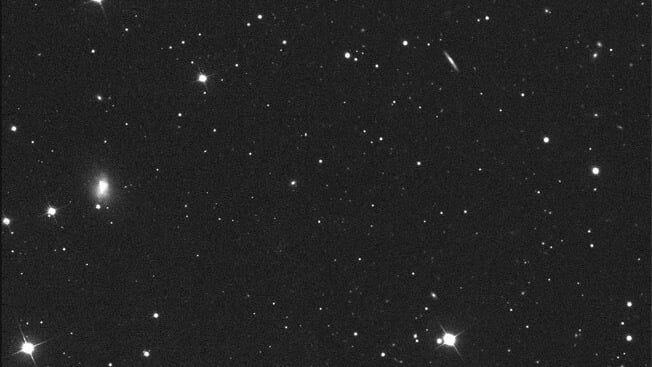Science
University Students Uncover Supermassive Black Hole in Nearby Galaxy

A group of astronomy students at the University of Texas has made a significant discovery, revealing a hidden supermassive black hole within the tiny galaxy Segue 1. This dwarf galaxy, located approximately 75,000 light-years from Earth, was previously thought to be primarily composed of dark matter. However, new research indicates that it may contain a black hole estimated to weigh over 450,000 solar masses, reshaping how scientists understand the structure of such galaxies.
The breakthrough began as part of a homework assignment in a course on Galactic and Gravitational Dynamics, led by professors Karl Gebhardt from UT Austin and Richard Anantua from UT San Antonio. The students were tasked with running computer simulations to analyze the dynamics of Segue 1, which was first identified in 2006 using the Sloan Digital Sky Survey telescope in New Mexico.
Previously, astronomers believed that the gravitational forces holding Segue 1 together were due to a dark matter halo, a theoretical cloud of invisible material surrounding the galaxy. In their simulations, the students divided into three groups to explore different scenarios. Their focus included dark matter, the presence of a black hole, and the distribution of stars within the galaxy.
The students’ analysis involved filtering out stars affected by the gravitational pull of the Milky Way to concentrate on those influenced by Segue 1’s gravity. They observed that stars closer to the center of the galaxy exhibited rapid, tight orbits, a strong indication of a central black hole’s presence. Ultimately, the models that incorporated this black hole provided the best alignment with the actual movements of the stars.
“It’s amazing,” said Nathaniel Lujan, a graduate student involved in the research. “We can hardly see Segue 1, yet it hosts a half-million solar-mass supermassive black hole in its center.” The findings were recently published in The Astrophysical Journal Letters, with several students credited as co-authors.
The implications of this discovery extend beyond Segue 1. The research suggests that supermassive black holes might be more common in smaller galaxies than previously believed. Lujan speculated that Segue 1 may have once been a larger galaxy, with interactions with the Milky Way stripping away gas and limiting star formation.
Black holes, defined by their gravitational pull so strong that even light cannot escape, have long fascinated astronomers. Their existence was uncertain until the first image of one was captured in 2019 by the Event Horizon Telescope, located in the Messier 87 galaxy, approximately 53 million light-years away. Black holes are characterized by an “event horizon,” a boundary beyond which nothing can return.
The students’ findings highlight the potential for further discoveries in the realm of dwarf galaxies. Lujan plans to continue his research for his doctoral thesis, utilizing advanced computing techniques and artificial intelligence to explore other dwarf galaxies traditionally thought to be dominated by dark matter.
In addition, the research aligns with recent observations made by NASA’s James Webb Space Telescope, which identified “little red dots” in the early universe. These objects appear to be galaxies with substantial black holes and minimal star presence. This reinforces the idea that black holes might play a critical role in the formation and evolution of galaxies.
As Karl Gebhardt remarked, the study serves as a reminder that reevaluating existing data can yield new insights. “These galaxies we are discovering, like Segue 1, may hold clues about the early universe, where massive black holes thrived,” he said. The discovery of a supermassive black hole in such a small galaxy exemplifies the evolving understanding of cosmic structures and the mysteries that continue to unfold in the universe.
-

 World3 days ago
World3 days agoCoronation Street’s Shocking Murder Twist Reveals Family Secrets
-

 Entertainment4 months ago
Entertainment4 months agoKate Garraway Sells £2 Million Home Amid Financial Struggles
-

 Entertainment3 months ago
Entertainment3 months agoAnn Ming Reflects on ITV’s ‘I Fought the Law’ Drama
-

 Health3 months ago
Health3 months agoKatie Price Faces New Health Concerns After Cancer Symptoms Resurface
-

 Entertainment3 weeks ago
Entertainment3 weeks agoCoronation Street Fans React as Todd Faces Heartbreaking Choice
-

 World4 weeks ago
World4 weeks agoBailey Announces Heartbreaking Split from Rebecca After Reunion
-

 Entertainment6 days ago
Entertainment6 days agoTwo Stars Evicted from I’m A Celebrity Just Days Before Finale
-

 World7 days ago
World7 days agoKevin Sinfield Exceeds Fundraising Goal Ahead of Final Marathons
-

 Entertainment3 months ago
Entertainment3 months agoCoronation Street’s Carl Webster Faces Trouble with New Affairs
-

 Entertainment3 months ago
Entertainment3 months agoWhere is Tinder Swindler Simon Leviev? Latest Updates Revealed
-

 Entertainment4 months ago
Entertainment4 months agoMarkiplier Addresses AI Controversy During Livestream Response
-

 Science2 months ago
Science2 months agoBrian Cox Addresses Claims of Alien Probe in 3I/ATLAS Discovery





















